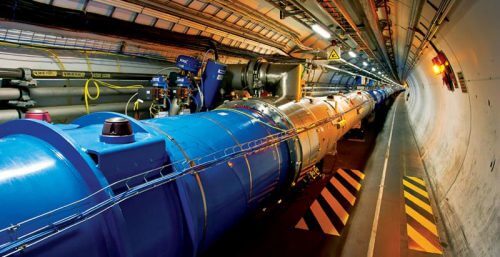Researchers have built a model according to which the mass of the Higgs boson, which helps produce the mass of elementary particles, changed in the early universe, and is therefore much smaller than the standard model of particle physics describes

How can we discover new information about the world around us and the material that makes it up? Particle physics is a branch of physics that studies elementary particles and the forces that act between them. The elementary particles are the building blocks of matter (which are not composed of other particles) - including electrons, quarks, photons and gluons - and there are interactions between them (such as mutual action, the force they exert on each other or an energetic collision between them). Many elementary particles do not appear in normal situations in nature but can be created and discovered during energetic collisions of other particles, as happens in particle accelerators.
Particle accelerators are devices that increase the speed of particles by moving them through electric and magnetic fields to create collisions between them, and the collisions are aimed at a detector that records and collects information about their products (new particles). In this way it is possible to decipher the properties of the particles that make up the matter in the universe and the forces that are transmitted between them.
Dr. Michael Geller from the School of Physics and Astronomy at Tel Aviv University is a theorist in particle physics. Theoretical physicists use theoretical and mathematical tools to describe natural physical systems and provide predictions about their behavior that can be tested through experiments and observations. In his research, Dr. Geller tries, among other things, to explain the mass of the Higgs particle, also in the context of the standard model of particle physics - which describes all known particles. This particle - Higgs - is responsible for the mass of all elementary particles through the interactions with them. Its own mass is also affected by these interactions. It was discovered, after a long effort, in 2012 at the LHC - the world's largest particle accelerator located on the Switzerland-France border.
"The standard model is the forefront of knowledge, but it has shortcomings and problems"
"It is true that the standard model of particle physics is the forefront of human knowledge, but it has shortcomings and problems. For example, the mass of the Higgs particle. The calculation of the Higgs mass, in the model, yields a relatively larger result than what is actually measured. This mass consists of interactions with many particles and each interaction has a different contribution and is much larger than the total measured value. In the past, many solutions to this problem were proposed, but with the activation of the LHC these predictions did not come true. In our research, we try to resolve this discrepancy," explains Dr. Geller.
In their latest study, which won a research grant from the National Science Foundation, Dr. Geller and his team sought to test the hypothesis that the Higgs mass was subject to changes in the first second of the universe's existence. According to him, "We focused on the early universe because we know that one second after the big bang began, the first elements (such as hydrogen and helium) began to form and the Higgs mass was already set to the value we know. Therefore, until the first second, with the expansion of the universe, the mass may have been subject to changes, so we focused on this point in time."
To test their hypothesis, the researchers built a mathematical model that expands the standard model - equations of particles and their interactions - and tested their solutions in the physical reality of the early universe, when it was much smaller and hotter. Thus they discovered that the dynamics between the new particles in the model and the Higgs destroyed any region where the mass of the Higgs was too large, which may explain why in the current universe the mass is smaller than expected.
"This is a preliminary study and the model we built is only one proposal for solving the Higgs mass mystery. The main part of the research is the attempt to confirm the model. We understood that for this purpose new experiments are required in accelerators, where it is possible to create the discovered particles and measure the interactions between them and the Higgs in dedicated detectors. We hope that this research is a first step in a completely new direction to solve the mystery", concludes Dr. Geller.
Life itself:
Dr. Michael Geller, 35 years old, married + child (6), lives in Kiryat Ono. In the past he was an Atudai in the Psagot program and served in Raphael. He plays the piano (also in bands), and likes to read and watch movies.
More of the topic in Hayadan:
